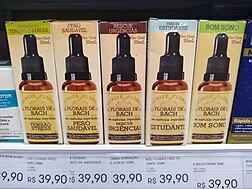Bach flower remedies
| This article is part of a series on |
| Alternative medicine |
|---|
 |

Bach flower remedies (BFRs) are solutions of
Description
The Bach flower remedy solutions, which contain a 50:50 mix of water and brandy, are called mother tincture.
Effectiveness
In a 2002 database review of randomized trials Edzard Ernst concluded:[3]
The hypothesis that flower remedies are associated with effects beyond a placebo response is not supported by data from rigorous clinical trials.
All randomized double-blind studies, whether finding for or against the solutions, have suffered from small cohort sizes but the studies using the best methods found no effect over placebo.[3][2] The most likely means of action for flower remedies is as placebos, enhanced by introspection on the patient's emotional state, or simply being listened to by the practitioner. The act of selecting and taking a remedy may act as a calming ritual.[3]
A systematic review in 2009 concluded:[2]
Most of the available evidence regarding the efficacy and safety of BFRs has a high risk of bias. We conclude that, based on the reported adverse events in these six trials, BFRs are probably safe. Few controlled prospective trials of BFRs for psychological problems and pain exist. Our analysis of the four controlled trials of BFRs for examination anxiety and ADHD indicates that there is no evidence of benefit compared with a placebo intervention.
A newer systematic review published in 2010 by Ernst concluded:[7]
All placebo-controlled trials failed to demonstrate efficacy. It is concluded that the most reliable clinical trials do not show any differences between flower remedies and placebos.
Flower remedies are sometimes promoted as being capable of boosting the immune system, but "there is no scientific evidence to prove that flower remedies can control, cure or prevent any type of disease, including cancer".[8]
Use
Each solution is used alone or in conjunction with other solutions, and each flower is said by advocates to impart specific qualities. Remedies are usually taken orally.[9]
The solutions may be recommended by a
The best known solution product is the Rescue Remedy combination,
Philosophy

Bach believed that illness was the result of a conflict between the purposes of the soul and the personality's actions and outlook. This internal war, according to Bach, leads to negative moods and to "energy blocking", thought to cause a lack of "harmony", thus leading to physical diseases.[12][13]: 9–10
Bach derived his solutions
Bach was satisfied with the method, because of its simplicity, and because it involved a process of combination of the four elements:[18]
The earth to nurture the plant, the air from which it feeds, the sun or fire to enable it to impart its power, and water to collect and be enriched with its beneficent magnetic healing.
By the time of his death in 1936 at 50 years of age, Bach had created a system of 38 different flower remedies along with their corresponding theories of ailments.[19]
See also
- Alternative medicine
- Herbal tonic
- List of ineffective cancer treatments
- Naturopathic medicine
- Quackery
References
- OCLC 428012690.
- ^ PMID 19470153.
- ^ PMID 12635462.
- ISBN 9780852072059
- ^ "FAQ: Do your essences contain alcohol?". feelbach.com. Archived from the original on 12 August 2014. Retrieved 11 August 2014.
- ^ "About the Bach Flower Remedies". bach-flowers.co.uk. Retrieved 14 April 2015.
- PMID 20734279.
- ^ "Flower remedies". Cancer Research UK. Retrieved 2 September 2013.
- PMID 36255345.
- ^
Candee, Andrea (2003). Gentle Healing for Baby and Child: A Parent's Guide to Child-Friendly Herbs and Other Natural Remedies for Common Ailments and Injuries. Simon & Schuster. p. 288. ISBN 0-7434-9725-2.
- ^
Gaeddert, Andrew (2004). Healing Digestive Disorders: Natural Treatments for Gastrointestinal Conditions. North Atlantic Books. p. 300. ISBN 1-55643-508-8.
- OCLC 16651016.[verification needed]
- OCLC 37322293.
- ISBN 1-85302-640-9.
- ISBN 1-55643-340-9.
- ^ a b
Larimore Walt; O'Mathuna Donal (2007). Alternative medicine: The Christian handbook, updated and expanded. Grand Rapids, Mich: Zondervan. p. 293. ISBN 978-0-310-26999-1.
- ^
Robson, Terry (2004). An introduction to complementary medicine. Allen & Unwin Academic. pp. 184–5. ISBN 1-74114-054-4.
- ISBN 1-58420-024-3.
- ^ "Life of Dr. Bach". Original Bachflower. Retrieved 20 April 2020.
